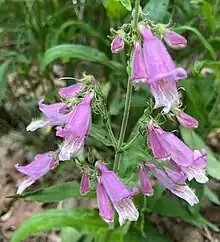Penstemon smallii
Penstemon smallii is a species of flowering plant also known as Small's penstemon.[1] They are native to the mountains of the Southeastern United States. They are state listed in Georgia (S1), Alabama (S1), Tennessee (S3), North Carolina (S3), and South Carolina (S2).[2]
| Penstemon smallii | |
|---|---|
 | |
| In situ at Blood Mountain, Georgia | |
| Scientific classification | |
| Kingdom: | Plantae |
| Clade: | Tracheophytes |
| Clade: | Angiosperms |
| Clade: | Eudicots |
| Clade: | Asterids |
| Order: | Lamiales |
| Family: | Plantaginaceae |
| Genus: | Penstemon |
| Species: | P. smallii |
| Binomial name | |
| Penstemon smallii | |
Description
They typically bloom in late spring or early summer with branched panicles of white to purple flowers.[1] They produce inflated tubular flowers 2- 3.5 cm long with two spreading lips, the lower much longer than the upper.[3] The upper lip has two lobes and the lower lip has three lobes, with the flower's throat having two strong ridges and abundant bearding.[3] The leaves are serrate, glabrous, and generally have a lanceolate shape with cordate bases.[3] Stem leaves are sessile, arranged oppositely, and clasp around the stem, though they also contain all the aforementioned elements.[3]
Ecology
Primarily found in the Southern Appalachians of the Carolinas, Georgia, and Tennessee, the species extends across the Ridge and Valley south into Alabama. There is also a population disjunction in the Piedmont of North Carolina within Wake County.[4] They are generally found within or around rock outcrops, glades, barrens, bluffs, and rocky slopes, preferring circumneutral soils lacking in fertility.[3] They are also known less frequently from open rocky woodlands, cliffs, and occasionally forest openings.[3] They are most often pollinated by bumblebees and wasps.[3]
References
- "Penstemon smallii (Small's Penstemon)". iNaturalist. Retrieved 2023-06-21.
- "NatureServe Explorer 2.0". explorer.natureserve.org. Retrieved 2023-06-22.
- "Penstemon smallii". georgiabiodiversity.org. Retrieved 2023-06-22.
- "2013 BONAP North American Plant Atlas. TaxonMaps". bonap.net. Retrieved 2023-06-21.
